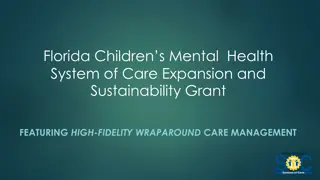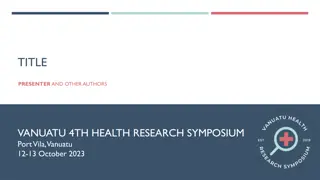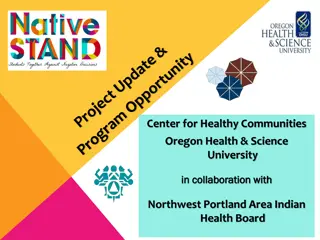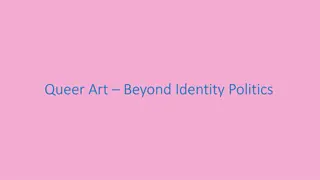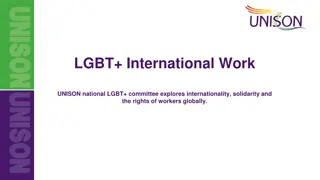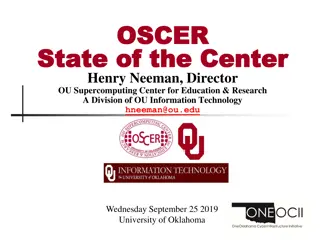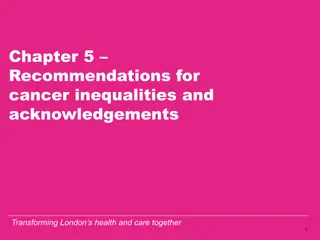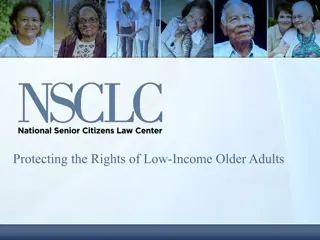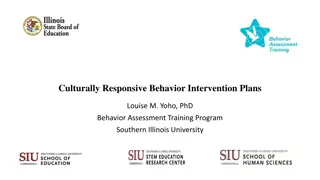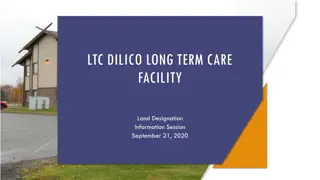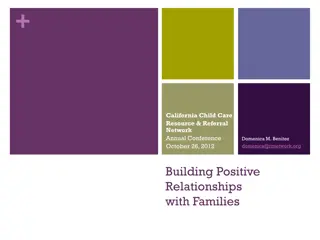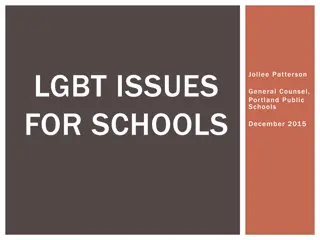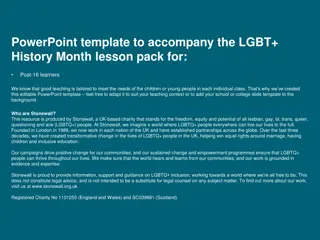LGBT Health & Culturally Effective Care Symposium Highlights
The symposium featured discussions on sexual orientation, gender identity, intersectionality, and health disparities for LGBTQ populations. Key terms, social determinants of health, and strategies to decrease barriers to care were addressed. Case studies were used to apply these concepts, and Carol Taylor-Shim shared insights on bias incident response. The event aimed to increase awareness of resources for improving care in this community.
Download Presentation

Please find below an Image/Link to download the presentation.
The content on the website is provided AS IS for your information and personal use only. It may not be sold, licensed, or shared on other websites without obtaining consent from the author. Download presentation by click this link. If you encounter any issues during the download, it is possible that the publisher has removed the file from their server.
E N D
Presentation Transcript
WELCOME! LGBT Health Culturally Effective Care Symposium November 8, 2017 Emily Noonan
What are we going to do today? Differentiate between Differentiate between sexual orientation, biological sex, gender identity and sexual orientation, biological sex, gender identity and gender expression gender expression Review a short list of Review a short list of key terms key terms that are important to this population that are important to this population Define Define intersectionality intersectionality and describe why it is important to understanding and describe why it is important to understanding health disparities for LGBTQ populations health disparities for LGBTQ populations Identify Identify social determinants of health and health disparities social determinants of health and health disparities for this population population Identify Identify strategies for decreasing barriers to care strategies for decreasing barriers to care for this population and solutions for decreasing health disparities solutions for decreasing health disparities Increase awareness of Increase awareness of resources resources to improve care to this population to improve care to this population Work through a Work through a case study case study to help you apply these concepts to help you apply these concepts for this for this population and
Carol Taylor-Shim Bias Incident Response Coordinator University of Kentucky
Cisgender Transgender Genderqueer Lesbian Gay Bisexual Queer Straight Pansexual Sexual orientation Gender Identity Sex Gender Expression Development Male/Female Difference(s) of sex development Intersex Gender non- conforming Gender conforming Model developed by Kristen L. Eckstrand, MD, PhD
Clinical Skills Tip When in doubt, ask! When in doubt, ask! Terms change constantly and carry different meanings for Terms change constantly and carry different meanings for different people. different people. Don t be afraid to ask your patients about Don t be afraid to ask your patients about their identity. their identity. Thank you for sharing with me that you identify as gender Thank you for sharing with me that you identify as gender nonconforming. Please tell me more about what that means nonconforming. Please tell me more about what that means to you so that I can provide you with the best care possible. to you so that I can provide you with the best care possible.
Use Do Not Use Transgender Transgendered Trans-man (FTM) Trans-woman (MTF) Transsexual DSD-affected, Intersex Hermaphrodite What name would you like me to use for legal or insurance purposes? What s your real name? Pre-op / post-op What pronoun would you like me to use? he-she, it Homosexual, sexual preference, lifestyle choice Gay, lesbian, LGBT, sexual orientation Gender-Neutral Terms They / Their / Them Partner Drop sir and ma'am
Understanding Sexuality Identity Attraction/ Desire Behavior
LGBT Populations DEMOGRAPHICS Transgender Identity: Limited studies = .3%1 Gay, Lesbian, Bisexual Identity: Estimates of the percent of adults who identified as LGB vary across surveys from between 2.2% and 4.0%, implying that between 5.2 million and 9.5 million individuals aged 18 and older are LGB.1 Behavior: Report same-sex sexual contact = 9%2 Attraction: Report at least some same-sex attraction = 11%2 At least one same-sex household in 99% of all United States counties.3 1. 2. Gates GJ. LGB/T Demographics: Comparisons among population-based surveys. Williams Institute: UCLA School of Law; 2014. Chandra A, Mosher WD, Copen C, Sionean C. Sexual behavior, sexual attaction, and sexual identity in the United States: data from the 2006-2008 National Survey of Family Growth. National Health Satistics Reports. 2011;3(36):1-36. Gates GJ. The Gay and Lesbian Atlas. Washington, D.C.: United Urban Press; 2004. 3.
History and context of LGBT health AIDs crisis AIDs crisis, 1980s LGBT identities LGBT identities pathologized Homosexuality removed from DSM in 1973 Homosexuality removed from DSM in 1973 GID removed and replaced by Gender Dysphoria in DSM in 2013 GID removed and replaced by Gender Dysphoria in DSM in 2013 Conversion therapy Conversion therapy widely used, without consent widely used, without consent Early variations included electric shock and chemical castration Early variations included electric shock and chemical castration Conversion therapies Conversion therapies still in use today still in use today, despite ample evidence that it causes harm and does not work that it causes harm and does not work , 1980s- -1990s pathologized by medicine/mental health by medicine/mental health 1990s , despite ample evidence more: http://www.aglp.org/gap/1_history/
Clinical Skills Tip How can you put fearful patients at ease? How can you put fearful patients at ease? Acknowledge their fears and reassure them. fears and reassure them. Acknowledge their For example, ask, What have your experiences been like For example, ask, What have your experiences been like before in mental health care? before in mental health care? Or say, Or say, I understand that you/people you know have experienced I understand that you/people you know have experienced harm, but know that the best practice now is .. I will follow harm, but know that the best practice now is .. I will follow best practices. best practices.
"TO TREAT ME, YOU HAVE TO KNOW WHO I AM CREATED BY THE NATIONAL LGBT CANCER NETWORK HTTPS://YOUTU.BE/DWJOGITKQ Q8
LGBT Disparities: Healthy People 2020 LGBT youth 2 to 3 times more likely to attempt suicide. More likely to be homeless (20-40% are LGBT) LGBT populations have the highest rates of tobacco, alcohol, and other drug use Gay men are at higher risk of HIV/STDs, especially among communities of color. Lesbians are less likely to get preventive services for cancer. Lesbians and bisexual females are more likely to be overweight or obese. Transgender people at greatest risk for suicide attempts; risk is mitigated by social support From Fenway Institute and
Health Care Disparities Experience by Transgender People 19% were refused care or expression, with even high numbers among people of color 28% verbally harassed verbally harassed in a medical setting 2% physically attacked physically attacked in a doctor s office 50% taught their medical providers taught their medical providers about transgender care refused care altogether, due to gender identity 28% postponed postponed or avoided 33% delayed or did not try avoided medical treatment when sick or injured did not try to get preventative health care Grant J, Mottet L, Tanis J. Injustice at Every Turn: A Report of the National Transgender Discrimination Survey. Natl Cent Transgender Equal Natl Gay Lesbian Task Force. 2011.; display adapted from Adapted from Chen, JC (2017) Educating Medical Students on Transgender Health, AAMC presentation
Health Care Disparities Experience by Transgender People I have been refused ambulance ambulance with numerous broken bones and wounds. refused emergency room treatment treatment even even when delivered when delivered to the hospital by by I was forced to have a pelvic exam forced to have a pelvic exam by a doctor when I went in for a sore throat doctor invited others invited others to look at me while he examined me and talked to them about my genitals. for a sore throat. The I have been living with excruciating pain who will examine my reproductive organs. (from a transgender man) excruciating pain in my ovaries because I can t find a doctor can t find a doctor Grant J, Mottet L, Tanis J. Injustice at Every Turn: A Report of the National Transgender Discrimination Survey. Natl Cent Transgender Equal Natl Gay Lesbian Task Force. 2011. Display adapted from Chen, JC (2017) Educating Medical Students on Transgender Health, AAMC presentation
Social determinants of health EXAMPLES Rejection of LGBTQ youth by families contributes to high rates of homelessness for LGBTQ youth. Economic Stability Lack of legal protections for LGBTQ people in housing and employment contributes to housing instability and financial instability for this population. EXAMPLES: Access to Primary Care Health care providers lack training contributes to patients dropping out of care, receiving sub-standard care, and concealing key information in care settings. Health and Health Care Widespread experiences of discrimination in healthcare contributes to delays of preventive care, resulting in poorer health outcomes. EXAMPLES: Social isolation of a stigmatized group forces socialization into bars contributing to higher rates of alcoholism, drug abuse and smoking. Social and Community Context Bullying of youth perceived to be LGBTQ is widespread and common, contributing to poor mental health outcomes for youth and adults.
Minority stress Chronically high levels of stress Chronically high levels of stress faced by members of stigmatized minority faced by members of stigmatized minority groups. groups. May be caused by a number of factors: May be caused by a number of factors: interpersonal prejudice and discrimination interpersonal prejudice and discrimination poor social support poor social support low socioeconomic status low socioeconomic status Numerous scientific studies have shown that minority individuals experience a Numerous scientific studies have shown that minority individuals experience a high degree of prejudice, which causes stress responses (e.g., high blood high degree of prejudice, which causes stress responses (e.g., high blood pressure, anxiety) that accrue over time, pressure, anxiety) that accrue over time, eventually leading to poor mental and physical health and physical health eventually leading to poor mental
National Calls to Improve Health Care for LGBT People Healthy People 2020 Department of Health and Human Services The Institute of Medicine The Joint Commission Association of American Medical Colleges (AAMC)
Solutions Seek further educational experiences that support your growth Increase self Increase self- -awareness of one s own assumptions and attitudes awareness of one s own assumptions and attitudes Learn clinically relevant information Learn clinically relevant information Learn and practice improved communication skills Learn and practice improved communication skills Advocate on behalf of this population in health care environments and in public policy Make your research inclusive by collecting demographics for these populations What is your sexual orientation? What is your sex assigned at birth? What is your gender identity? Ask questions; avoid assumptions in order to get accurate information that support your growth
Strategies for culturally effective care Build trust by creating an inclusive health care environment Inclusive non-discrimination policies and intake forms Visual cues in waiting rooms, rainbow lapel pins Record patient name in use and pronouns; advocate for system-wide use Advocate for training for all staff/providers; advocate for safe, respectful work places Build trust by acknowledging potential distrust of medical systems and professionals Ask Have you had any poor experiences with health care providers in the past? and listen. Assure confidentiality and ask questions about SO and GI in all situations where it could be important to patient care Assure confidentiality Assure confidentiality Ask permission before you record LGBT identity into EHR Ask permission before you record LGBT identity into EHR Use universal language ( How would you like to be addressed? Do you currently have a partner? ) Use universal language ( How would you like to be addressed? Do you currently have a partner? ) Do not ask questions out of curiosity; contextualize sensitive questions to establish clinical relevance Do not ask questions out of curiosity; contextualize sensitive questions to establish clinical relevance
Resources: Local Metro Louisville P Metro Louisville P- -FLAG FLAG: : www.pflaglouisville.org PFLAG stands for Parents and Friends of Lesbian and Gays. Support group for families and friends PFLAG stands for Parents and Friends of Lesbian and Gays. Support group for families and friends when someone comes out and educational center for families. Trans when someone comes out and educational center for families. Trans- -inclusive. www.pflaglouisville.org inclusive. Louisville Youth Group: Louisville Youth Group: LYGmail@louisvilleyouthgroup.com LYGmail@louisvilleyouthgroup.com; ; http://www.louisvilleyouthgroup.com/ Youth group for LGBTQ youth to provide support and social networks. Youth group for LGBTQ youth to provide support and social networks. http://www.louisvilleyouthgroup.com/ OutCare OutCare Health: This national organization hosts a state This national organization hosts a state- -level directory of LGBT providers. providers. Health: Local Provider Directory of LGBT Local Provider Directory of LGBT- -Friendly Providers: Friendly Providers: www.outcarehealth.org www.outcarehealth.org level directory of LGBT- -friendly health care and mental health friendly health care and mental health Transwoman National: Transwoman National: www.transwomennational.org www.transwomennational.org Adult group for persons identifying on the trans Adult group for persons identifying on the trans- -feminine spectrum. feminine spectrum. LGBT Center at LGBT Center at UofL Supports an inclusive campus environment for all faculty, staff and students. Supports an inclusive campus environment for all faculty, staff and students. UofL: : www.Louisville.edu/LGBT www.Louisville.edu/LGBT Fairness Campaign: Fairness Campaign: www.fairness.org Statewide political organization working towards equal rights for LGBT citizens Statewide political organization working towards equal rights for LGBT citizens www.fairness.org
Resources: National Family Acceptance Project This organization uses a research-based, culturally grounded approach to help ethnically, socially and religiously diverse families to support their LGBT children, thereby decreasing negative health and mental health outcomes such as suicide. www.familyproject.sfsu.edu The Fenway Institute National LGBT Health Education Center The mission of Fenway Health is to enhance the wellbeing of the lesbian, gay, bisexual and transgender community through access to the highest quality online education for health care professionals for the care of LGBTQ patients and populations. All online modules are free and qualify for continuing education credits. http://fenwayhealth.org/the-fenway-institute/education/the-national-lgbt-health-education-center/ Gay and Lesbian Medical Association (GLMA) GLMA's mission is to ensure equality in healthcare for lesbian, gay, bisexual and transgender (LGBT) individuals and healthcare providers. Offered online: GLMA: Guidelines for Care of LGBT Patients. www.glma.org Center of Excellence for Transgender Health (San Francisco) The mission of the Center of Excellence for Transgender Health is to increase access to comprehensive, effective, and affirming health care services for trans and gender-variant communities. http://www.transhealth.ucsf.edu/
Case Study To prepare for this exercise, we need the person with the purple sticker to act as a scribe to take notes on the worksheet your facilitator will give you. Everybody have one?
Case StudyRound 1 Jaime is a Latino 14-year-old adolescent who was assigned male at birth. Jaime and his parents are Catholic and are active in their neighborhood parish, which is predominantly Latino and Spanish-speaking. Jaime was born with a genetic condition that affects the kidneys, ears and eyes, leading to hearing loss, eye abnormalities, and progressive kidney disease. With so many other issues, Jaime s oral health is somewhat neglected. Jaime frequently sees a variety of specialists for his kidneys, eyes, and ears, but you are part of his primary care team. Two years ago (when Jaime was around the age of 12), at a routine visit to you, Jaime s mother asked if you could provide a referral for a therapist. She felt that Jaime started to become sadder for no apparent reason and his grades in school started to slip. You referred Jaime to a therapist who works well with depressed adolescents, wondering if his chronic physical problems are affecting his mental health or if his medical problems have made him a target for teasing at school.
Round 1 Questions 1. What are some key health issues the patient faces? (3 minutes) 2. What are some of the barriers to high quality care the patient faces? (2 minutes)
Case StudyRound 2 Several months have passed. The therapist recently called you, Jaime s primary care provider, at the request of Jaime s parents. The therapist sounded alarmed, reporting that Jaime mentioned in a session that he thought he was having crushes on other boys, and questioned the counselor whether he might be gay. The therapist s comment to you: I don t really specialize in these issues. Shortly thereafter, your staff received a call from Jaime s school indicating that he had made a suicidal statement after an incident of bullying: I just don t know if I want to continue living anymore. You learn that the therapist shared with the parents that Jaime thinks he might be gay, later stating that it was okay to break confidentiality because a safety issue was at hand. The parents repeatedly asked Jaime if he might be going through a phase.
Round 2 Questions 1. What key concerns do you now have about Jaime s health and health care? (2 minutes) 2. From both a clinical and non-clinical perspective, what strategies would you recommend to meet the needs of this patient? (2 minutes)
Case StudyRound 3 Jaime is now 16 and has come to your office today for a routine checkup. Your clinical assistant goes to the waiting room and looks for a teen male but cannot identify one. After calling the name Jaime, an adolescent with long hair and wearing makeup stands up. The assistant acts surprised, and nervously states, Oh, you weren t what I was expecting, eliciting stares from other patients. During your clinical visit, Jaime notes that their feelings of depression have gotten worse, as have the symptoms of their genetic condition. As part of your conversation with Jaime you ask, At this point in time, what gender do you identify with? Jaime looks surprised, but says, I m not sure, but I do know I feel female and I feel best when I m dressing this way. You ask Jaime what pronouns they would like you to use, and Jaime responds, they and them works for me. Seeming relieved that you have asked these questions, Jaime tells you about the Gay-Straight Alliance at school, reporting that even though this year has been difficult, they feel safe with this group. Jaime also tells you that even though their parents had initially struggled with the idea that Jaime might be gay, they now accept this. Jaime s parents have told Jaime that they love and support them no matter what. You ask Jaime how they are coping having to see so many specialists, and Jaime replies, It s hard, you know. The doctors understand kidneys and stuff, but I don t get treated nice because I look different.
Round 3 Questions 1. Is Jaime gay? Is Jaime transgender? How could you figure this out? (2 minutes) 2. How do Jaime s social identities affect their health and the care they receive? (2 minutes) 3. What strengths does Jaime have that may help them meet the challenges of their own health and health care? (3 minutes)
Debrief In an ideal world, how could all of the professions In an ideal world, how could all of the professions represented at your table work together, as an represented at your table work together, as an interprofessional interprofessional team, to provide care for Jaime and team, to provide care for Jaime and their family? their family? What are you taking away from this activity? What are you taking away from this activity?
Contact information Stacie Stacie Steinbock Steinbock, Director, LGBT Center on the HSC , Director, LGBT Center on the HSC Campus Campus stacie.steinbock@louisville.edu stacie.steinbock@louisville.edu Emily Noonan, Research Coordinator, LGBT Center on the Emily Noonan, Research Coordinator, LGBT Center on the HSC Campus & Undergraduate Medical Education HSC Campus & Undergraduate Medical Education emily.noonan@louisville.edu emily.noonan@louisville.edu




